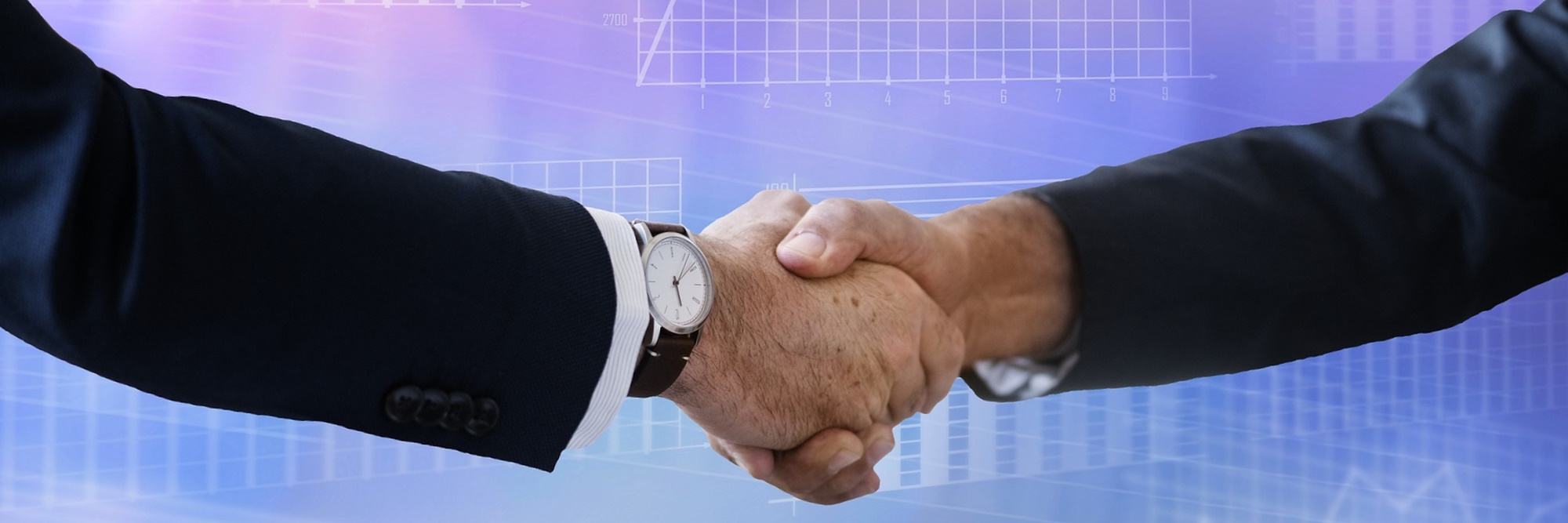
Innovative, integrated, holistic
Networked services from a single source
While many companies with overlaps in the security sector concentrate on just one aspect, i.e. manufacturers want to provide the best possible hardware, service providers focus on the realisation of projects and training providers focus on further training, the Security Robotics team sees itself as a more complete provider. As a developer of software and hardware solutions, we network all relevant components with each other using our central software platform. We take over the integration and support of complex & modular robotics solutions for our customers.
Our services start with consulting & concept, move on to application development & interface networking, followed by integration & training through to service & support and bundle all necessary, complementary and interrelated services under one roof. Based on the customer’s already installed smart end devices (actuators such as cameras, light barriers, motion detectors, etc.), we create well thought-out, efficient concepts and utilise existing connections wherever possible. Thanks to our modular software tools, we can handle any configuration on site and any type of control centre and programme any necessary adjustments quickly and independently.
Data protection
From a legal perspective, security robots are mobile cameras. The European General Data Protection Regulation (GDPR) is mandatory for companies operating in the European Economic Area. Its clear and strict legal principles also govern the use of security robots, the handling of video and sensor data, their encrypted transmission, etc.. In terms of data protection law, therefore, only the existing specifications and guidelines within the company need to be expanded to include these types of mobile camera systems.
Data theft? No chance!
The servers used by Security Robotics are protected against unauthorised access and failure using state-of-the-art technologies. This keeps personal data where it belongs, under lock and key and secure.
We not only provide our software solutions and robot platforms, but also embed them in accordance with the security concept, create and train routes, modify communication tools, test and set up Datastream, inform the employees involved, etc. The integration of robotic components frees the customer’s employees from routine tasks such as patrolling, which can be handled much more efficiently, reliably and comprehensively by mobile systems. The variety of application scenarios is constantly growing and allows human employees to play to their strengths in a focussed manner at neuralgic decision-making positions.
Thanks to our practical training courses, the robot quickly becomes not only a valued but also an understood colleague, which will be utilised more and more easily and sustainably thanks to the new knowledge. If simple troubleshooting is no longer sufficient, we access the systems, sensors and software components remotely, analyse, find and usually solve the problem directly. In the case of extensive mechanical or hardware problems, an experienced robot integrator also provides support directly on site.
Your requirements are changing, expansions are pending, you need to respond to new regulations or laws? Even then, we are and will remain your competent partner, curious about challenges.
Are you curious about our services, would you like to see for yourself and talk to us about solutions for your individual project?
Then don’t hesitate any longer and get in touch with us!
Contact us!
FAQ – Services
Which services does Security Robotics offer?
Security Robotics is an IT system house, experienced software developer and integrator in the field of robotics + AI with the following specialisations:
Innovative security robots: we deploy state-of-the-art security robots equipped with advanced sensors, cameras and intelligent algorithms. These robots ensure effective surveillance of large areas and can perform specific tasks such as patrols, inspections and hazard detection autonomously. Robots are also offered as an efficient Robot as a Service (RaaS) solution in addition to being sold.
Networked robotics systems: Our networked robotics systems enable the seamless integration of various safety components. By intelligently networking robots, sensors and software, we create a comprehensive safety infrastructure that can be flexibly customised to our customers’ requirements.
Intelligent software solutions: We develop and implement intelligent software such as ACUDA for the efficient control and integration of safety systems. This software enables precise control of robotic systems, the evaluation of real-time data and integration with other safety infrastructures and is offered as a Software as a Service (SaaS) concept.
Training courses: Security Robotics places great emphasis on the training of security personnel and support staff. Our training programmes cover the effective use of security robots
Can robotic systems be adapted to changing safety requirements?
Yes, adaptations and extensions to the rented robotic systems are possible in order to respond to changing safety requirements. This includes the integration of new sensors, software updates and adjustments to patrolled routes. Continuous adjustments ensure that the rented systems remain at the cutting edge of security technology and are a sustainable part of modern security architectures.
How does Security Robotics ensure that the customer’s data protection guidelines are adhered to?
Close dialogue with the customer’s data protection officer and the security service providers involved is of central importance to Security Robotics. We ensure continuous coordination to ensure that all data protection guidelines are adhered to. This collaborative approach makes it possible to take individual requirements into account and ensure maximum data security throughout the entire life cycle, from consulting, implementation and operation to support and updates.
How is data protection compliance ensured when using rented robotic systems?
Data protection compliance when using rented robotic systems is ensured by comprehensive measures. These include data protection guidelines, encrypted data transmission, limited access to stored data and regular security audits. Providers work closely with companies to ensure that the use of robotic systems complies with applicable data protection regulations.
How is data security guaranteed for robotic safety systems?
The data security of rented robotic systems is ensured by encrypted communication and comprehensive security measures. Providers such as Security Robotics implement advanced encryption technologies, secure protocols and conduct regular security audits to ensure the protection of sensitive data. European and customer-specific data protection regulations are strictly adhered to and customers have control over access to their security data.
Broadly diversified and strong in the industry – our service portfolio
In the automotive industry
|
Autonomous robots are revolutionising the automotive industry. From self-driving assembly robots to AI-controlled quality inspections: They optimise production processes. Drones monitor stock levels, walking robots inspect components and mobile robots transport materials. Safety patrol models ensure a protected working environment. A system such as SPOT from Boston Dynamics supports the automotive industry in the inspection of assembly processes and the transport of materials. Wheeled robots such as ARGUS are ideal for safety patrols and the protection of production facilities and storage areas. A PROMOBOT can accompany visitors on interactive tours and provide information about the latest vehicle models. |
In industrial plants
|
Industrial plants benefit greatly from the use of autonomous systems. Robots such as SPOT inspect systems, check weld seams, temperature values, machines, etc., while BEEHIVE drones are suitable for exploring areas that are difficult to access. Self-driving transport robots move goods, while collaborative robots cooperate directly with human workers and take over digital check-in services for deliveries, for example. And finally, ARGUS systems monitor the perimeter and inspect potentially dangerous areas. These technologies increase safety and productivity. |
In the agricultural sector
|
Agriculture has been focussing on autonomous solutions for several years. Drones map fields and identify crop requirements. Soil robots plant seeds and harvest, while autonomous tractors cultivate arable land. AI-based systems analyse plant health and control irrigation, leading to higher yields. Specifically, a SPOT can be used in agriculture to monitor livestock herds and fields. ARGUS systems are perfect for continuously patrolling extensive arable areas, even in difficult weather conditions. The BEEHIVE drone system from Sunflower Labs, on the other hand, helps to detect wild animals that could jeopardise the harvest. |
On sites and construction projects
|
Nowadays, construction projects are also planned and recorded digitally. BIM (Building Information Modelling) benefits greatly from modern robotics. Drones create precise 3D models of the construction progress from outside, while a SPOT can also scan and inspect floor by floor from inside. Construction quality and workmanship can also be checked automatically. Unauthorised access to construction sites can be ideally prevented by a combination of camera towers and agile response tools such as BEEHIVE drones. In the event of an incident, intruders are recognised at an early stage and notifications are sent to security teams. |
In the chemical and raw materials industry
|
Innovative technologies support many processes in the chemical and raw materials industry: drones monitor plants for leaks and damage. Robots collect samples in hazardous environments, measure gas concentrations and scan for leaks and radiation. AI models analyse chemical reactions in real time, optimise production and reduce risks. In extensive outdoor facilities, along pipelines and conveyor belts, wheeled robots can perform security and maintenance tasks in parallel. Autonomous and all-terrain systems such as SPOT have proven their worth within plants, including in mining, and inspect defined areas independently. |
At trade fairs and as reception service
|
At trade fairs, robots interact with visitors, provide information on exhibits and guide them to different stands. Reception robots greet guests, facilitate check-ins and provide directions. These technologies create a modern, welcoming experience. Walking robots such as SPOT often serve as eye-catching stand companions and elegantly demonstrate the current state of autonomous AI robotics. PROMOBOTs from RDI Robotics act as personal reception assistants, giving visitors directions and providing information about events. Multilingual, charming and interactive, the human-like robot lowers touch thresholds and can be customised to any role. The very wide range of on-board electronics and functions such as temperature measurement, personal identification, document scanning, receipt and photo printing, online payment, etc. help with this. |
For end customers
|
End customers experience the benefits of autonomous technologies in everyday life. Robots vacuum, mow the lawn and assist with maintenance. Delivery drones bring orders home, while service robots offer guests comfort in hotels. Interaction with such robots is becoming increasingly intuitive and personalised. A PROMOBOT could also support end customers in the private sphere as an interactive household assistant, providing information and entertaining people as an interactive communication talent. BEEHIVE drones are positioned centrally to secure large private premises and then act at lightning speed to control potential intrusion attempts. |
In the finance and insurance industry
|
Autonomous assistants in the financial sector offer customers virtual advice and support with financial decisions. AI models analyse market data and help with investment strategies. Claims settlement robots speed up the process and minimise human error. PROMOBOT offers visitors to banks information about various financial services, can pre-qualify their enquiries and provide advice. Mobile robotics would be able to autonomously protect ATMs or cash deposits. Last but not least, modern security systems at the customer’s premises ensure that claims are proactively prevented and that the insured event does not have to occur. |
In the catering and tourism industry
|
Restaurants use robots as waiters to serve food and take orders. In hotels, robots accompany guests to their rooms and provide room service. Drones provide spectacular aerial shots of tourist attractions and create unforgettable experiences. A communication genius like PROMOBOT also feels at home in these sectors, taking over guests in restaurants and hotels from the first friendly hello and check-in and providing comprehensive information about restaurant menus, hotel services and local attractions. At night, the PROMOBOT installed at the access points also acts as a conspicuous security system. |
In the healthcare sector
|
Hospitals use autonomous robots for dispensing medication, optimising stock management and sterile transport. Robots assist surgeons in precise procedures, while mobile platforms collect patient data and support nursing staff. PROMOBOT can welcome and advise patients in hospital lobbies and provide information about medical facilities. SPOT is used as an ideal platform for various research approaches and scores highly with its modular equipment, i.e. the use of specialised sensors, manipulators and data collectors. |
In the cultural sector
|
Museums are integrating robots to provide visitors with information about works of art. Robots offer interactive tours and bring history to life. Virtual artificial intelligence models enable personalised explorations and create unique cultural experiences. Thanks to a permanent network connection, a PROMOBOT, for example, can call up real-time information, e.g. about changes to exhibitions, in-depth information about the respective events, check and book tickets, and serve as a seat allocator and advisor for visitors. For outdoor events and exhibits, a supplementary installation of the BEEHIVE drone system makes sense for security purposes; inside museums, halls and corridors, SPOT independently takes over security patrols at night. |
In the logistics sector
|
The logistics industry is already a highly automated sector. Drones enable fast and precise parcel deliveries, and the trend is increasing. Warehouse robots sort and organise goods, while driverless transport vehicles facilitate the transport of materials between warehouses and factories. Some warehouses and loading processes can do completely without human colleagues on site. It is therefore only logical to automate security and utilise all information in a central network. This primarily concerns autonomous systems for perimeter security and patrolling indoor and outdoor storage and storage areas, specifically models such as ARGUS and SPOT. |
On oil production sites
|
Confined spaces, narrow corridors, risky zones and hazardous environments, which are all part of the oil production environment, are ideal for assigning a variety of tasks to technology instead of humans. Autonomous robots can, for example, carry out regular inspections of critical plant components. They check pipelines, drilling rigs and other equipment for leaks, corrosion or damage. This enables early identification of problems and targeted maintenance. SPOT is already being used multiple times for exactly these tasks & is proving its worth every day, up and down the stairs. Drones can be used to monitor the environmental impact of oil production. They fly over water sources, land areas and surrounding ecosystems to detect possible pollution or ecological changes. This supports compliance with environmental regulations. Drones such as BEEHIVE are also perfect for quickly collecting + transmitting information in emergencies. Recordings and live streams of accident sites can thus be analysed directly and decisions can be made on a relevant basis. |
In the manufacturing industry and among manufacturers
|
Production facilities use autonomous robots in the process itself for the assembly, testing and packaging of products. Robots co-operate with human workers or carry out complete production steps independently according to specifications. Mechanisation and automation thus noticeably increase efficiency and quality. As with logistics, safety robots are instead responsible for perimeter protection, securing defined access areas and rapid alarm verification when required. |
Building & security service provider
|
Robots effectively support human security personnel and also work hand-in-hand with them. Thanks to effective networking, the employee is always informed, can also access sensor data and camera images from the robotics and can also control them directly if necessary.
Models such as SPOT and ARGUS take over repetitive, boring and strenuous tasks such as hour-long patrols instead of security guards: day / night / in all weathers. The security experts, on the other hand, use the validated real-time data to quickly make the right decisions and trigger follow-up measures.
The robots’ thermal cameras can also provide invaluable services when it comes to preventive fire protection, reporting even the smallest deviations. Drone-based fire safety inspections in particular are efficient, cost-effective and digitally mappable.
|
In sport and at events
|
Sport is movement, so mobile robots are not only ideally suited to such an event, but are also ideal for keeping an eye on the mostly extensive sports areas with high-performance cameras and sensors. Drones in particular have been used for a long time and provide spectacular images and an overview, even in stadiums. But regardless of whether it is a stadium or an open space, robotic systems quickly provide the necessary overview, check access zones and, thanks to their autonomy, provide the security experts on site with the perfect support. At events of all kinds, communication models such as PROMOBOT provide information, provide entertainment or look after visitors, help with check-in and much more. When night falls, autonomous SPOTs or ARGUS roam the sports facilities and event areas. |
Under radiation
|
Radiation-exposed zones are environments in which people can only stay for a short time and with protective equipment. Instead of putting people in danger, mobile robots are used, which autonomously follow defined routes and collect data, check hotspots and take measurements. Alternatively, it can also be controlled remotely to carry out targeted maintenance, repairs, etc. A very mobile walking robot like SPOT can be modified to fit precisely and, for example, can also be used for manipulations, smaller repairs and point measurements with a 3-axis arm. Speaking of SPOT: This has already been successfully used several times on the site of the former Chernobyl nuclear power plant. ARGUS robots are suitable for perimeter protection of such KRITIS structures or final repositories, and BEEHIVE threat systems are suitable for lightning-fast response to alarm messages. |
In the energy and environmental sectors
|
Autonomous robots help monitor renewable energy systems. Extensive construction sites can be ideally protected for their duration with autonomous systems, fixed systems can close potential security gaps with robots and drones can work as alarm devices. Even in “classic” power plants, AI systems and robotics strengthen protection and help detect/prevent potential acts of sabotage and theft right from the start. Drones quickly and reliably inspect wind turbines and solar systems for damage. Ground robots collect environmental data and analyze air quality. This contributes to the efficiency of energy production and environmental protection. |


















